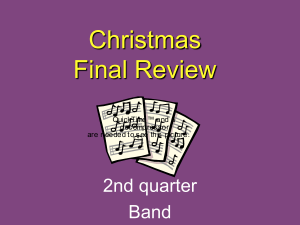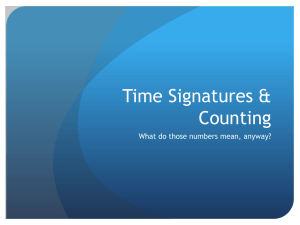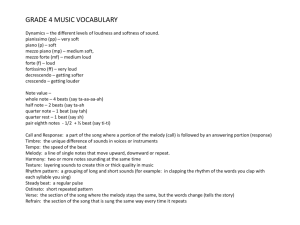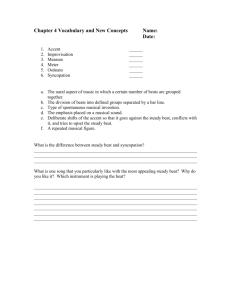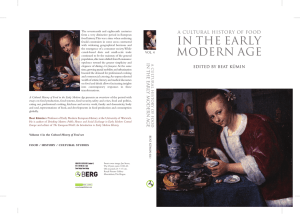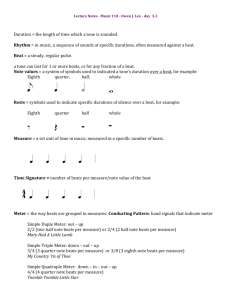Sr. Band Final Review
advertisement
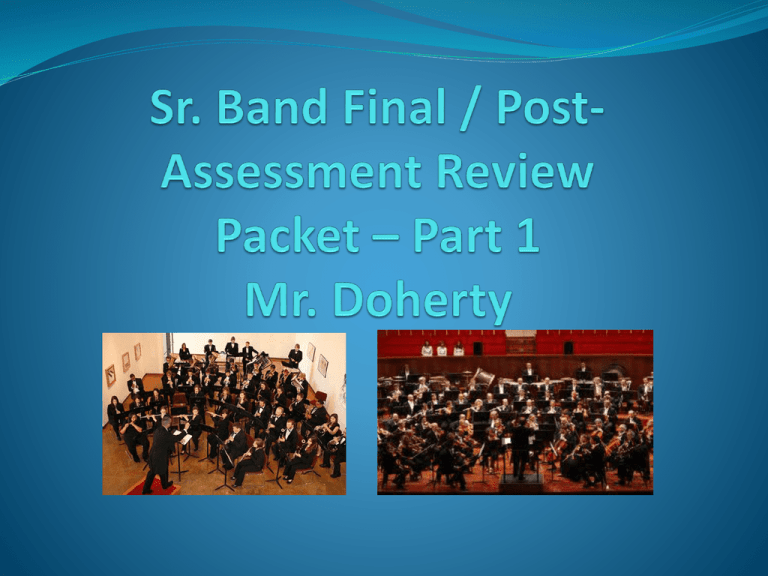
Piano= Soft Forte=Loud Mezzopiano = Medium Soft Mezzoforte = Medium Loud Crescendo (cresc.) Means to get louder Pianissimo= Very Soft Fortissimo= Very Loud Diminuendo (dim) means to get softer Grave = Extremely Slow Accelerando means to get faster Largo = Very Slow Adagio = Slow Ritardando means to get slower Moderato = Moderate Speed Andante = Walking Speed Allegro = Fast and joyful Vivo / Vivace = Very Fast = Four beats in = Two beats in = one beat in = half a beat in = Three beats in = The “dot of prolongation adds half of the note value to the primary note Counted One-e-and-a Counted One-e-a Counted One-and-a Counted One-a Counted One-e-and Counted One-e Triplet = 3 notes in one beat in Quintuplet = 5 notes in one beat in Septuplet = 7 notes in one beat in Quarter rest = 1 beat Eighth rest = ½ beat Half rest = 2 beats 16 rest = ¼ beat Whole rest = 4 beats Multiple measure rest (15) The Entertainer – Ragtime music features many accented offbeats. 4 beats per measure a quarter note gets one beat Common time = 4/4 Three beats per measure a quarter notes gets a beat A Waltz is in ¾ time Five beats per measure a quarter note gets a beat Cut time means there are two beats per measure and a half note gets a beat Marches are often in cut time 6 beats per measure an eighth note gets a beat Coda – an added ending on a piece of music Segno, or Italian for sign Repeat sign Accent – emphasize this note D.S. – Dal Segno = back to the sign D.C. – Da Capo = back to the beginning Fermata – hold this note until the conductor cuts you off Caesura – a complete stop in a piece of music Treble Clef (G Clef) tells you where the note G is. Bass Clef (F Clef) tells you where the note F is. A natural means to play the Regular note, it gets rid of A sharp or a flat Staccato notes are played short and detatched Ex. A sharp raises a note a half step Ex. A flat lowers a note a half step Tutti – everyone plays Unison – many instruments playing the same notes Enharmonic – two different names for the same note Ledger lines – notes played outside the staff Chromatic Scale – a scale with all half steps Ritardando – slowing down Simile – play the notes the same as before Interval – the distance between two notes Sforzando – a type of harsh accent Half step – the distance from a note to it’s “sharp” (Ex. C to C#). Scale – an ascending series of seven notes in the pattern WWHWWWH Whole step – two half steps Divisi – divided parts. Ostinato – a repeated musical passage Arpeggio – notes of a chord played seperately. Db = ? A# = ? G# = ? Gb = ? Bb = ? F# = ? Key of _____ Key of _____ Key of _____ Key of _____ Key of _____ Key of _____ 1. Once a note is flat or sharp in a measure it stays flat or sharp. 2. A natural will cancel out a previous flat or sharp in a measure. 3. The bar line cancels out any sharps or flats from the previous measure. What is the name of the last note? What is the name of the last note? What is the name of the last note?
